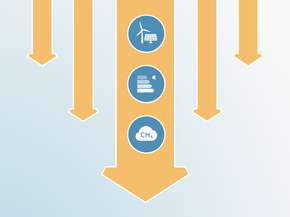Country summary
Overview
South Africa's new government is focusing on energy system stabilisation and security, pursuing expansion of both fossil and renewable energy supply. Amid an ongoing energy crisis, it is progressing with the legal adoption of sectoral carbon budgets and expanding the country’s renewable energy generation capacity. But, concurrently, the government continues to target growth in controversial fossil gas capacity and appears to be delaying its shift away from the country's heavy coal reliance as it props up the struggling state-owned electricity company Eskom.
Uncertainty remains on the future of South Africa’s power sector due to a lack of a recent centralised public plan. The government has not yet published an updated Integrated Resource Plan (IRP) since releasing the now-outdated 2019 version. The coal plant decommissioning roadmap, indicated in the 2019 IRP, appears to have been delayed and new coal capacity was added to the grid in 2024. Overall, the CAT continues to rate South Africa’s climate targets and policies as “Insufficient”.
Recent government publications imply a continued reorientation towards a more market-based and decentralised energy system. Procurement auctions for additional wind and solar capacity were held in 2024 and tax incentives have been implemented to support the growing trend of households and businesses installing solar and batteries. The Presidential Climate Committee (PCC) recommended renewables and battery storage as least cost options, as well as the full phase-out of coal but left the potential role of gas an open question, indicating that more research would be required. Meanwhile, the government actively pursues new fossil gas capacity with a procurement round proceeding in 2024.
South Africa continues to struggle with an unstable electricity system. Chronic undersupply of electricity and ongoing load shedding are persistently impacting the economy and the everyday lives of South Africans. In attempts to resolve the crisis, the government is beginning to implement significant structural reforms. Greater participation of privately owned utility-scale generation and small-scale distributed generation is being pursued.
Government efforts to reform Eskom, South Africa’s public electricity utility, are also ongoing. Debt relief for Eskom, equivalent to over half of the company’s debt over three years, commenced in 2023 to enable investment and maintenance of the power system. The unbundling of Eskom’s transmission and distribution functions is also progressing with the passing of the Electricity Regulation Amendment Act in 2024, paving the way to establishing an independent state-owned transmission system operator.
South Africa has advanced several positive climate policies and measures:
- Adoption of the Climate Change Act: in July 2024, South Africa’s President Ramaphosa signed the Climate Change Bill into law. The Climate Change Act represents a significant strengthening of climate governance for South Africa. Under the legislation, the government must set sectoral emission targets for each GHG emitting sector in line with the national emission target every five years. Carbon budgets will also be allocated to large-scale GHG emitting companies, intended to place a cap on emissions and make it mandatory for companies to constrain their emissions.
- Expanded funder base in the Just Energy Transition Partnership (JET-P): at COP26 in 2021, South Africa, France, Germany, UK, the US and the EU made a political declaration to establish a long-term partnership to support South Africa’s pathway to low-emissions and climate resilient development. Since the announcement of the partnership, additional international donors, (including the World Bank, the African Development Bank and CIF), increased the available funding from USD 8.5bn to USD 13.8bn. In early 2025, the USA unfortunately left the partnership. However, its withdrawal of less than 10% of the funding still leaves USD 12.8bn of committed funding from other partners, and South Africa is actively seeking additional partnerships.
- Development of the Just Energy Transition Implementation Plan (JET-IP): South Africa presented the JET-IP in November 2022, which details financing needs of USD 98bn over the next five years for catalysing a sustained just energy transition. The JET-IP outlines how best to direct the initial offer of USD 8.5bn from donor countries to priority investment areas. The initial funds will mostly go to the power sector, supporting a just transition away from coal, with additional investments in new energy vehicles, primarily battery electric vehicles, and green hydrogen. 2024 has been the first year of active implementation with USD 2bn reported expenditure as of early 2025.
- Accelerating renewable energy expansion: the share of wind and solar in total electricity generation is growing, more than doubling between 2019 and 2023, from 4.5% of total generation in 2019 to 11.6% in 2023. Key policies supporting the uptake of renewables are the Renewable Energy Independent Power Producer Procurement Programme (REIPPPP) and the removal of licencing requirements for distributed generation projects of up to 100 MW in size. The government has also introduced tax rebates to incentivise installation of rooftop solar by commercial and residential customers. The most recent public auction rounds for renewable electricity and battery capacity were oversubscribed and South Africa imported record amounts of solar panels in 2023 and 2024.
While there has been progress on procuring renewables and removing barriers to private participation, transitioning away from fossil fuels still faces challenges. To meet its ambitions for a just energy transition, South Africa could:
- Follow the guidance of the Presidential Climate Committee (PCC) and pursue a low-cost, renewables-based electricity system. While PCC recommendations on the role of fossil gas remain unclear, all least-cost models reviewed by the PCC add no new coal or nuclear due to high costs and a transition to more affordable renewables with co-located storage.
- Accelerate the decommissioning of coal and set an ambitious phase out plan for coal power plants incorporated into key national plans including the finalised JET IP and updated IRP. New coal capacity additions are neither cost-effective nor compatible with limiting global warming to 1.5ºC. Recent CAT analysis shows South Africa needs to cut its coal power reliance significantly by 2030 and phase it out by 2040. However, South Africa added 800 MW of new coal capacity in 2024 and plans additional capacity in 2025.
- Increase assistance to coal communities who are most affected by the coal phase-out to ensure a smooth and just transition for affected groups, building capacity and necessary administrative infrastructure, and setting out clear and predictable plans.
- Prioritise urgent investments in transmission and distribution. As specified in the JET IP, investment in transmission and distribution infrastructure is critical to ensure uptake of private sector-driven deployment of renewable energy. Grid infrastructure will need additional, external support in the form of concessional finance and budget assistance.
- Set ambitious sectoral budgets under the Climate Change Act and strengthen the carbon tax to ensure effective decarbonisation incentives. Emissions exceeding the agreed carbon budget thresholds are intended to be penalised with a higher rate of carbon tax. It is thus imperative that the penalty for excess emissions is sufficiently high to avoid negating the impact of the sectoral carbon budgets.
- Develop targeted policy interventions for the transport, building and industry sectors. These sectors are substantial emitters in South Africa but have not received sufficient policy attention to date. New sectoral targets under the Climate Change Act are an opportunity to enhance focus on these sectors. Recent analyses by the Climate Action Tracker indicate that the steel industry’s emissions intensity would need to be reduced by about 30% by 2030 and EV market share would need to increase to 50–95% by 2030 and 90–100% by 2040 to be compatible with the Paris Agreement. However, comprehensive public plans targeting emissions in these sectors are not available.
The CAT rates South Africa’s climate targets and policies as “Insufficient”. The “Insufficient” rating indicates that South Africa’s climate policies and commitments need substantial improvements to be consistent with the Paris Agreement’s 1.5°C temperature limit.
South Africa is not meeting its fair share contribution to climate change mitigation. South Africa’s NDC and policies and action are both rated as “Insufficient” when compared to its fair share. South Africa’s NDC is rated as “Almost sufficient” considering against modelled domestic pathways. As a country with lower responsibility, capability, and per-capita emissions, South Africa should receive international support to set an ambitious conditional NDC target beyond its national fair share and implement the policies necessary to achieve it.
The updated 2030 emissions reduction target submitted to the UNFCCC in September 2021 follows the Presidential Climate Commission recommending 350-420 MtCO2e (incl. LULUCF).
South Africa’s 2030 NDC target has a range, of which we rate the upper end, because reaching that would comply with the NDC.
To get a better rating South Africa needs to increase its climate target’s ambition and implement associated policies that can curb the growth in national emissions and set them on a downward trend. We rate South Africa’s current policies and actions as “Insufficient”. This rating indicates that South Africa’s climate policies and action in 2030 need substantial improvements to be consistent with the 1.5°C temperature limit. If all countries were to follow South Africa’s approach, warming would reach over 2°C and up to 3°C.
Under current policies, South Africa will not reduce emissions enough to meet its NDC target range for 2030.
South Africa’s recent progress on policies and actions is mixed. Commendable progress has occurred with the passing of the Climate Change Bill in July 2024. The country now needs to set sectoral carbon budgets, including for certain companies. A second phase of the carbon tax will soon commence, with a proposal out for comment. Given the intended role of the carbon tax to penalise emissions which exceed the future carbon budgets, a sufficiently stringent rate takes on new importance.
Expansion of renewable energy supply continues in South Africa with new rounds of renewable energy procurement auctions held, most recently in summer 2024. Licencing barriers to small scale solar PV installations have been removed and tax incentives are in place for households and businesses to install their own solar PV. These measures have been followed by record imports of solar panels and batteries into the country in 2023 and 2024.
Yet, uncertainty over the prioritisation of decarbonisation of the power sector persists. Coal plant decommissioning appears to have been delayed and Eskom added new coal generation to the grid in 2024. The government is also pursuing an expansion of fossil gas generation with an open auction round for new capacity as of end-2024.
If considering South Africa’s planned but not yet implemented policies, our rating of policies and actions would go up to “1.5°C compatible”. The stringent implementation of proposed economy-wide and sector-specific policy measures would enable South Africa to achieve at least the top end of its NDC range, falling within the current range.
It should be noted that CAT policy projections for South Africa rely on outdated energy system planning documents from the South African government. Future updates will incorporate more up to date national energy system scenarios as they become available. Please refer to the assumptions section for further information.
The full policies and action analysis can be found here.
We rate the updated 2030 reduction target levels as “Almost sufficient” when compared to modelled emissions pathways. The “Almost sufficient” rating indicates that South Africa’s NDC in 2030 is not yet consistent with the 1.5°C temperature limit but could be with moderate improvements. If all countries were to follow South Africa’s approach, warming could be held at—but not well below—2°C.
The CAT rates South Africa’s reduction target based on the upper range of its target, which falls in the “Almost sufficient” range, even if close to the limit to “1.5°C compatible”. If South Africa were to meet the lower end of the range it would be 1.5°C compatible when compared to modelled emissions pathways; however, it would still fall short of its fair-share contribution.
South Africa currently relies on foreign investments and international finance support to implement a large percentage of its climate change programmes, and the government also emphasises in its updated NDC that the implementation of its NDC will be enabled by financial support as specified in the Paris Agreement.
We rate South Africa’s 2030 NDC target as “Insufficient” when compared with its fair-share contribution to climate action. The “Insufficient” rating indicates that South Africa’s target needs substantial improvements to be consistent with limiting warming to 1.5°C. The target is at the least stringent end of what would be a fair share of global effort and is not consistent with the 1.5°C limit, unless other countries make much deeper reductions and comparably greater effort. If all countries were to follow South Africa’s approach, warming would reach over 2°C and up to 3°C.
CAT interprets the full NDC target as unconditional. As South Africa only needs to reach the upper end of the target range to fulfil the NDC, we rate that emissions level. If South Africa committed to meeting the lower end of its target range, the rating would change to “Almost sufficient” when compared to the fair share contribution.
The CAT currently does not evaluate South Africa’s net zero target given its preliminary nature and a lack of more detailed information. We will do so once further information is communicated by the government.
Further analysis
Latest publications
Stay informed
Subscribe to our newsletter




